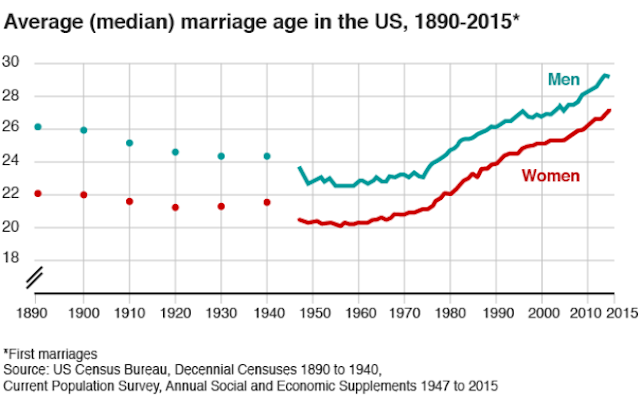The movies have exhibited for us all the stereotypical types of love. Young love in the 1991 classic My Girl. A very handsome DiCaprio trapped in a forbidden love in Romeo + Juliet. Puppy love between Sandy and Danny in Grease. Duckie’s unrequited love in Pretty in Pink. The epic and undeniable “true love” in Gone With the Wind. But real life now is showing us… Belated love?
A new trend has been emerging on either side of the globe. People are waiting longer and longer to get married. The median age for marriage in both the United States and United Kingdom has grown substantially since the late 19th century. We can see that in 1890 the median marriage age in the US was approximately 26 for men and 22 for women. The age gap has persisted, but was originally present due to the fact that men were enrolled in school before marriage; whereas women were not and could wait patiently for a suitor to approach them in all of their bountiful youthfulness. An unsteady decline to low median ages of approximately 20 for women and 23 for men in the 1950s led to a dramatic increase over the next half century. As of 2015, the median marriage ages have risen almost to the thirties.
We have a significant understanding of why the median age has risen throughout history, but how can we explain the steeper trend of recent? Researchers like Eric Klinenberg have theorized two things. He postulates that these changes can be linked to the advent of the internet and newer technology and deeper cultural shifts.
Decades ago family connections were among the most common ways to secure a romantic partner. By the 1980s, nearly 40% of couples met through mutual friends. By the turn of the century, the internet was the major player in introducing romantic partners. In 2013, we were introduced to dating applications like Tinder, Hinge, Bumble, Coffee Meets Bagel, the list goes on. This put the dating scene at our fingertips however exhilarating or exhausting that may be. What is certainly true is that the search for romance is taking those looking for love further than their local watering hole.
In terms of the deeper cultural shift mentioned earlier, it would seem that today people are in no particular rush to find their soulmates. The precursive life stage of young singles to marriage has been coined by sociologists as "emerging adulthood" or "extended adolescence". This emphasis on an extended life stage of independence has incited a shift in cultural values. Young people are pursuing careers, hobbies, friendships, and non-committal romantic relationships in this stage. As a result, they are pressing pause on marriage.
--
http://www.bbc.com/news/magazine-35535424






No comments :
Post a Comment